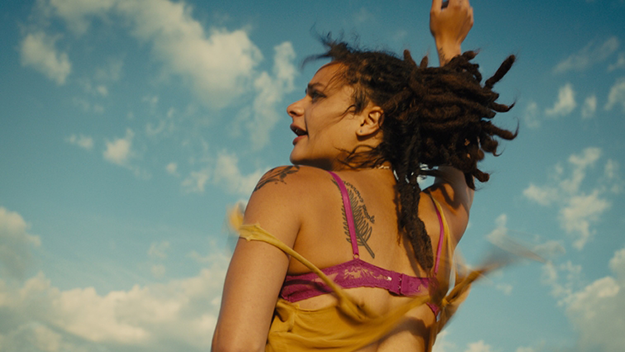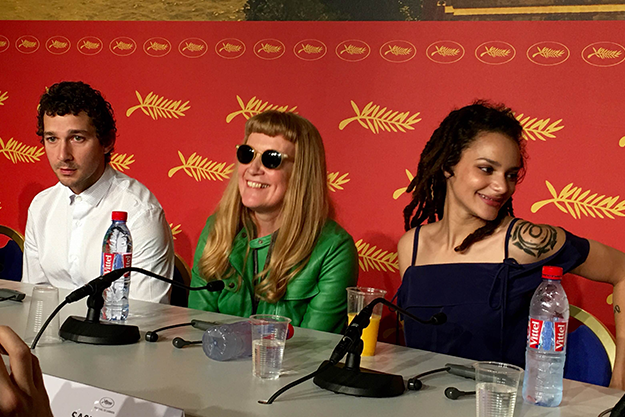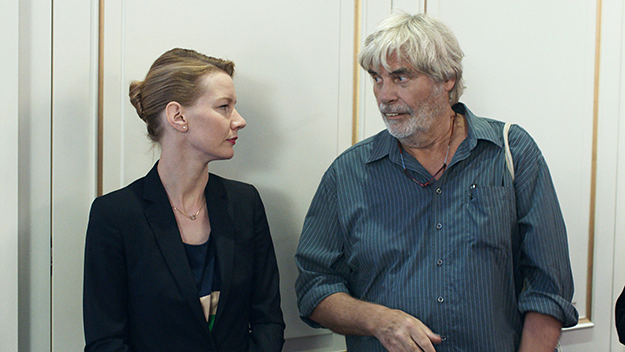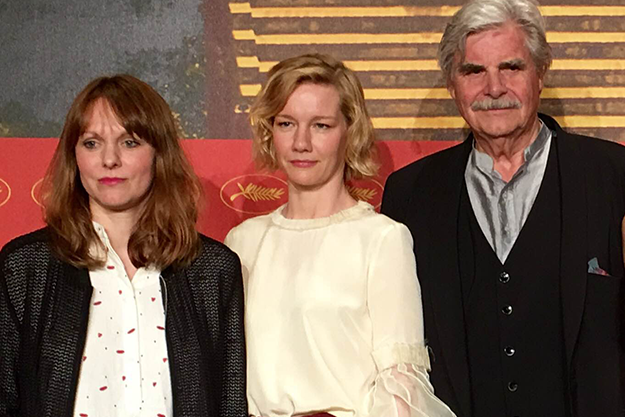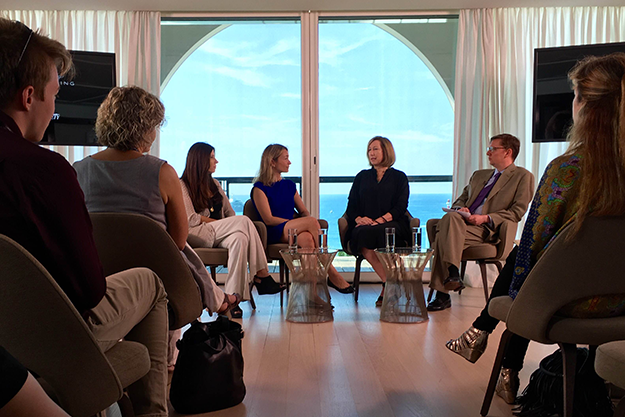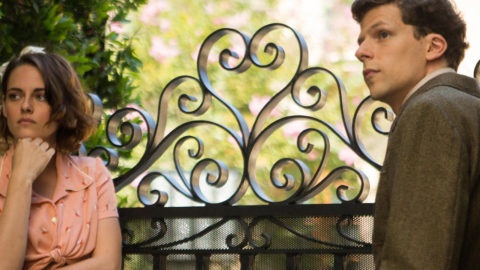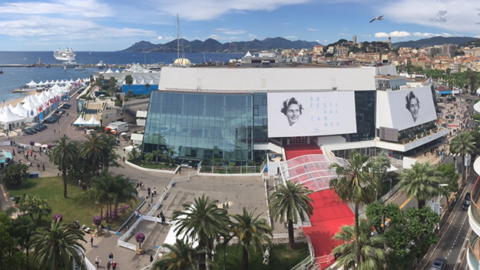Cannes Dispatch #2: American Honey, Toni Erdmann, and Women in Motion
The Cannes Film Festival experienced a moment of pure exuberance on Sunday afternoon as Andrea Arnold and her new film’s cast of kids, some wearing baseball caps and multicolored tuxedos, danced to E-40’s “Choices (Yup)” on the red carpet before entering the Lumière Theatre for the gala premiere of American Honey. Kristen Stewart danced along at the bottom of the stairs, waving her arm and bouncing in solidarity to the beat of the song.
Cannes came alive in its first weekend following the premieres of two strong entries, both directed by women. A festival that has faced persistent criticism for the underrepresentation of female filmmakers in its Competition section front-loaded two new movies—Maren Ade’s Toni Erdmann and Arnold’s American Honey—in prime opening-weekend slots.
The crew of American Honey dances on the #Redcarpet of American Honey by Andrea Arnold #Cannes2016 #Competition https://t.co/SXz7qvbSEx
— Festival de Cannes (@Festival_Cannes) May 15, 2016
In Panama City Beach, Florida, on spring break two years ago, college freshman Sasha Lane was walking on the sand when she was spotted by Andrea Arnold as a potential actress for a film that the British director was to begin shooting a few weeks later. The Texas teen had never acted before but that didn’t discourage either Arnold or Lane. (In fact, of the 15 young people who appear in the film, just three of them—Shia LeBeouf, Arielle Holmes, and Riley Keough—had ever acted before.) They hung out on the beach, walked down a pier, and later grabbed a meal together at a Waffle House. Arnold staged an audition in a hotel lobby and then got on the phone with Lane’s mom to make the pitch for permission to cast the young woman as the lead in her movie.
“I felt Andrea’s vibe,” Lane explained during a press conference Sunday afternoon at the Cannes Film Festival. “She just came up to me, she just seemed like really nice, she was smiling. She was in her overalls. I was really happy that day.”
Shot on the road in the heartland of the United States—Oklahoma, Kansas, Nebraska, North Dakota, and South Dakota—American Honey follows the journey of a ragtag group of disenfranchised American youths. Inspired by a 2007 New York Times article about crews of kids working as door-to-door magazine salespeople, Arnold staged a road trip that lasted nearly two months. Arnold, the kids, and DP Robbie Ryan traveled nearly 12,000 miles together to shoot the movie.
American Honey
Lane shines as Star, an 18-year-old Texan who is trapped inside a broken family. One day at a K-Mart she catches a bunch of kids dancing in unison to Rihanna’s “We Found Love” and spots ringleader Jake (Shia LaBeouf). She is immediately taken with him and her life changes in an instant. Star joins the teen crew and hits the road.
Managed by a domineering twentysomething (Keough) and her boy-toy sidekick (LaBeouf) who dole out cash after taking a commission, the outcasts fan out in a new town and go door to door trying to sell magazines by day and then reconvene at night to dance, drink, and hook up, crashing at a roadside motel before getting up the next day to do it all again.
In order to shape the script, Arnold researched the world that rural American kids like these live in today, and she relied on the stories and experiences of some of her cast members, whose backgrounds were similar to those she had read about in the New York Times article.
The more time Arnold spent traveling the country and researching these kids, the clearer her view became. And, as with any road trip, the journey is punctuated by a playlist. In fact, American Honey unspools as a sort of musical, pulsating with the energy of rap, country, and pop music (Sam Hunt, Kevin Gates, Lee Brice, Juicy J, and more) strung together to bind its episodic segments.
Photo by Eugene Hernandez
It may seem a bit on the nose, but Rihanna’s “We Found Love” recurs in the film, a pitch-perfect anthem for a dramatic turning point in a young girl’s life. Star embraces its lyrics as she rides the roller coaster of her bond with the elusive Jake. Like the song, American Honey is bleak yet hopeful.
The soundtrack for the film was inspired by the tunes that the kids were listening to at the time, but Rihanna’s “We Found Love” was an unlikely choice. The young people weren’t into it, but Arnold was, so when the shooting began the director asked LaBeouf to dance to the tune at the K-Mart.
“It meant a lot to me at the time. I love Rihanna,” Arnold explained yesterday. “Shia didn’t like dancing to Rihanna,” she laughed, and the actor concurred during the press conference: “It was day one of shooting. It was very awkward amongst the boys in the group. Everybody was alpha male-ing [and Andrea said] I need you to body roll to Rihanna. It was a little bit awkward.”
The director, a 2004 Oscar winner for her short film Wasp who has since screened features Red Road and Fish Tank here in Cannes, recalled an eye-opening trip to a tiny West Virginia town. It had multiple pharmacies but little else to offer. Chatting with a local pharmacist, she was told that business was brisk, doling out painkillers for older people and antidepressants for the kids. “Once I started looking at it, I realized that I didn’t know the United States really well,” Arnold said at the festival press conference. “I did a whole bunch of road trips to make a connection with it.”
“I find real life and real people inspiring.” Arnold added. “That’s where I go to. I try and find my own way, I try and find my own voice.”
Toni Erdmann
During multiple moments of Toni Erdmann, the latest feature by German filmmaker Maren Ade, the audience here at Cannes burst into applause. The loudest reaction came after an unexpected musical moment that united the film’s father (Peter Simonischek) and daughter (Sandra Hüller) in a fitting (and moving) duet.
“I thought about it when editing the film, or even before,” Ade said during a press conference. “Might there be applause? I was not sure if I would like that.” Yet, she conceded, “it’s a great thing when people applaud in your film!”
The musical sequence, a casual cover of a 30-year-old iconic American pop song, is so special because late in the movie it bonds two people who have struggled to navigate their strained relationship. Adults entering new phases of their lives, the father and daughter are at odds and unable to find a way to rebuild their familial bond.
In this extraordinary film, Hüller plays an uptight corporate woman named Ines, recently relocated to Romania for work, and Simonischek stars as her fumbling, playful father Winfried, who, desperate to connect with his daughter, dons a disguise and takes on an alternate persona named Toni Erdmann.
In early scenes, Ines is seen as sharply focused on her career, but later, when her dad enters the picture as Erdmann, he seems to disrupt the equilibrium she has created in her life. His gags and antics seem like the sort of dress-up games that parents instigate when their kids are young. But with his daughter all grown up and trying to play the role of a mature adult, his stunts set the stage for an intense conflict between the two.
Photo by Eugene Hernandez
Moments of pain and humor are interwoven throughout Ade’s dramatic and hilarious new movie as Ines and Winfried spar and share. Father and daughter struggle with how to relate to each other. Their outlooks have evolved to the point where the differences between them are striking, and there’s an increasingly poignant interplay at work exploring how each is navigating their personal and professional lives.
Clocking in at 162 minutes, Toni Erdmann takes its time unraveling its lead characters’ personas and building toward a powerfully cathartic conclusion.
“My film is less a plea for letting go than a plea for coming clean,” Ade said in press notes about her aims for this movie.
Following screenings this weekend here in Cannes, Toni Erdmann was widely considered by many to be among the very best in the early days of this year’s Competition.
“Father and daughter is such an emotional topic,” Ade explained during a press conference on Saturday, adding that she sought to strike a delicate balance between the humor and seriousness of these characters and their relationship. “The most important part was to be precise,” Ade said. “The viewer of a film, when you have this realism, can be pulled out of it very easily.”
Photo by Eugene Hernandez
Celine Rattray, an executive producer on Andrea Arnold’s American Honey, was in production with a well-known cinematographer last year and it was a tough day on set. The crew had limited time at a location, so Rattray went to the DP and his all-male camera crew to check in and urge the group to move quickly to hit their goals for the day. As she walked away from the group, she heard the male cinematographer tell his cohorts: “Maybe we’d be moving quicker if there weren’t so many women in charge.”
Rattray, at one of Kering’s Women in Motion panel discussions in Cannes this weekend speaking alongside Sundance Institute chief Keri Putnam and Hollywood talent agent Rena Ronson, said that she could only laugh at the way she was dismissed by the male camera team.
As the most important film festival in the world, Cannes has been under considerable scrutiny for not having more films by women in its Official Selection. Last year, organizers established a series of public conversations to explore the roots of these challenges women face. Saturday’s session, held in a well-appointed suite with dramatic views of the Croisette and the Mediterranean, focused on the state of affairs in American independent film.
Panelists shared stories of progress and a guarded sense of optimism that recent attention can instigate lasting change for women in the industry.
The #OscarsSoWhite hashtag not only created awareness for ethnic diversity but also raised questions about the inclusion of women in all areas of filmmaking, noted Rattray. She added that even more impactful was Jennifer Lawrence’s first-person piece about equal pay for women published in Lena Dunham’s Lenny Letter. The essay was widely read and shared, intensifying the spotlight on such issues, Rattray emphasized.
“Everyone is cognizant now, there’s awareness and desire,” agreed Ronson, who is co-head of the film department at UTA, a leading Hollywood talent agency that packages films and reps talent. “We are seeing [women] on the list now, we are putting them on the list.”
Putnam’s colleagues at Sundance spent four years collaborating with USC on a survey about women in Hollywood. She said that when the effort began, the number-one reason for the lack of diversity in the industry was the profound lack of awareness of the problem.
Putnam shared stats that illuminate deep issues facing an industry aimed at equality. It will take time, she warned. Even at Sundance, where female filmmakers account for 23 percent of the films submitted for consideration and 25 percent of the movies selected to screen at the festival, Putnam said there is more work to be done, noting: “25 percent is not 50 percent.” All panelists agreed that female filmmakers are finding more success in the documentary realm, where budgets are smaller. The narrative world of movies being greenlit by Hollywood is the most challenging. “When money comes in, women go out,” Ronson cautioned.
“I think it’s happening and I think everyone is very aware and conscious,” Rattray offered optimistically about the indie sector of the industry. “I do think it’s easier in the independent world.”
“Now is the time,” Ronson stated. “I see change.”



